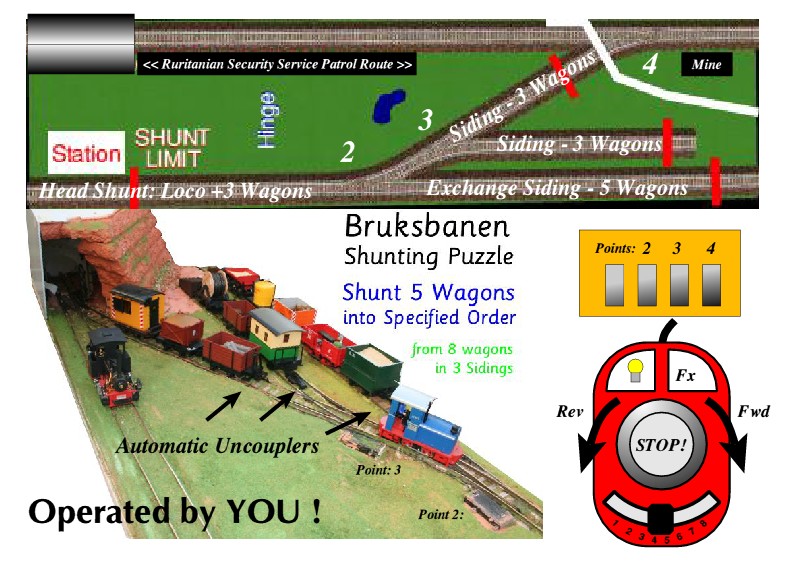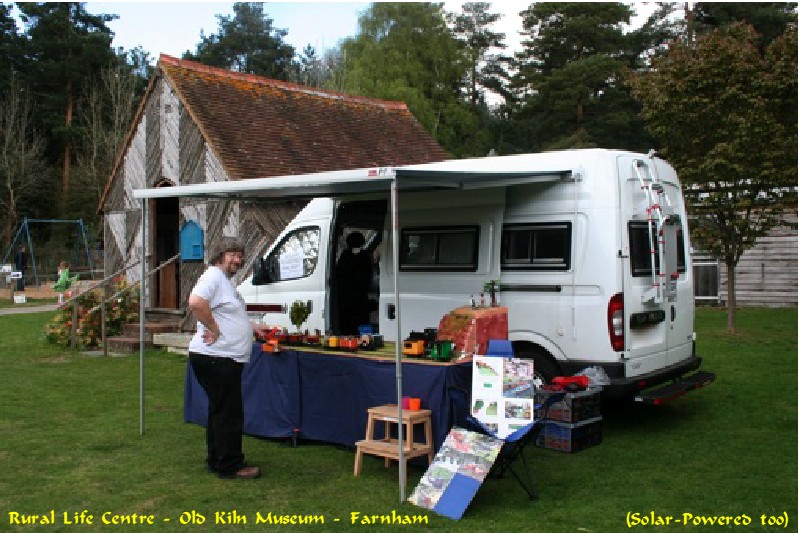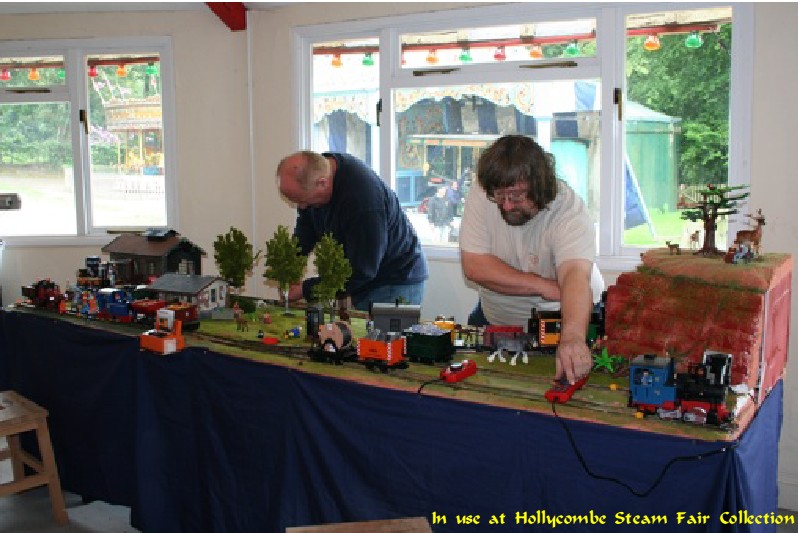Bruksbanen - The Shunting Puzzle with a "Scandinavian Theme"
Part One: Bruksbanen Mk1 - The Folding-End Version - 2007
with Roco DCC Control, and Automatic Uncoupling
Bruksbanen - the name means Factory Railway in Norwegian or Swedish (depending on the en or an ending)
is an example of the Inglenook Shunting Puzzle which attracted Lin's attention some years ago...(2007)

Perhaps with Lin's extended travelling times to Canary Wharf, or the household disruption of our extension,
her desire for a portable layout which could be used when we visited shows, grew, whilst the garden Layout
declined without each evening's running session.

Early Appearances were at Wickham in 2007..and Ilfracombe MRS, Narrow Gauge South
Kenavon Show - Reading and also the Rural Crafts Centre nr Farnham where we used our van's Solar Power Supply.

Then there was Hollycombe: Here Glyn Smith is seen assisting with the set-up at Hollycombe
From the beginning, it was going to be a feature of the layout, that show-visitors, young and old, would be encouraged
to try their hand at the puzzle. A set of 8 cards was made from which upto 5 could be selected (but perhaps only 1 at
a time for some very young operators)

At the time, we owned 'RE CUE'; a Range Rover Ambulance, which could therefore carry a 2m long layout with ease.
A standard internal door, from Wickes, was a cheap and 'lightweight' base - much like the 'Beattieboard' of Phil's first Trebl'0'lectric
layout.
However, in G Scale,a length of 3m was needed for the design, and so a half-length door off-cut was attached
with a piano hinge, at the 'Station'/headshunt end, which was folded back underneath for transit; requiring the removal of its track
and buildings each time.
To break away from the flatness of most layouts, the full door had Expanding Foam sprayed on, to create an undulating surface.
The plain track was ALL 'unwanted' Radius 1 ('Start Set') curves which had been straightened using a track bending tool.
This helped give Bruksbanen Mk1 its 'rustic' 'Secondhand Industrial' Layout look and feel, as none of the track was perfectly straight.
DCC was to be used to control the trains (plural) as we had decided that it was essential to guarantee movement at all times by
having a 'rear-track' which does not form part of the puzzle, either to 'distract' the operator if they were finding it too easy,
or to fill in the gaps between their moves, if needed. Visitors used a simple Roco Lockmaus 2, and LGB Rocker switches for the points,
whilst we had a Roco Multimaus which gave us control of all locos and the points.
A 16Vdcc track voltage, with CV5 used in each loco, restricted the maximum speed of locos to about 1/4-1/2 speed.
As a result, Bruksbanen's locos are not normally used on the garden lines, as they then appear to be too slow!
Bruksbanen Mk1 abided by the 'KISS' principle: 2 wires for dcc power throughout. DCC COULD be used for remote point operations, by us,
because the wires were laid alongside the track, on short posts in a similar way to the underground, but the visitors used the LGB
switch box, mounted on the front, to change the points, which used the traditional EPL motor mounted visibly alongside.

The rear-track design required a tunnel to allow 'our' train to disappear from view: This became a (Playmobil) Castled Mine entrance,
which in turn, with the timing of the first show(s) it was taken to, becoming a 'magic mine' producing gold and more,
because something very distinctive and amusing was required for the younger operators to identify the specific wagons -
although these were all very different 'field' railway wagons. Note thattthe cards, whichare still in use today, were produced before
the contents were selected by Lin. Obviously an essential back-train was the Bachmann Dressine Trolley
belonging to the Military Intelligence Service, MIS and therefore Dcc number 15, frequently seen leaving the mine with a chest full of treasure.
Uncoupling was 'hands free' by using the standard LGB sprung uncoupler in each siding; requiring precise position control, as they
backed the wagons up to uncouple. IT also required free-running wagons with sufficient inertia: metal wheels and heavy clay loads beneath the
surface filling. It was intended to change the loads for different shows - especially for the 'more reserved' railway modellers, but
this had never happened. From the back track Easter Eggs could get awarded at Easter Shows, etc.
The layout would be up and running at a show wthin 20 minutes of arrival- and then Lin would spend the remaining time until opening adding animals etc.
On to 'Bruksbanan Mk2'
Back to the Solent Home Page Back to the Fillin Home Page
For SOLENT GROUP matters please use this new dedicated address..

(Copyright Phil and Lin Spiegelhalter 2000-2016)




